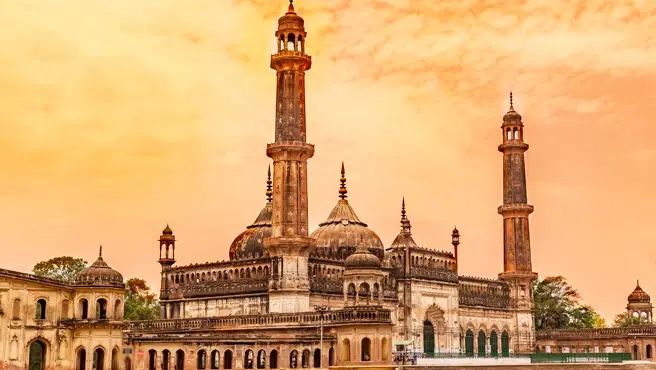
Hotels
•04 min read

Akbar Fort Agra stands as one of the most iconic monuments of the Mughal era. This majestic site is a symbol of history and unity. It is recognized as a UNESCO World Heritage Site and offers visitors a glimpse into the grandeur of a bygone era. In this blog post, you will learn about the fascinating history of this fort, Akbar's enduring legacy, and the architectural brilliance that defines it. Our goal is to answer your frequently asked questions about Akbar Fort Agra and to spark your interest in exploring its rich cultural tapestry.
Akbar Fort Agra was built by Mughal Emperor Akbar in the 16th century. The fort stands as a landmark of his vision for a unified empire. It was constructed as both a military stronghold and a royal residence. This fort, often described as a fort built by Akbar, played a central role in establishing Agra as the capital of the Mughal Empire. Its strategic location and robust defenses made it vital for the administration of the empire. The fort holds tales of battles, celebrations, and royal gatherings that highlight its enduring position in history.
Often known as Agra Fort, Akbar Fort Agra forms an integral part of Agra Fort history. Over the centuries, it has witnessed numerous historical events. Later Mughal rulers enhanced and expanded the fort. Its walls and structures tell the story of a vibrant past. Every corner of the fort speaks to the vibrant lives of the people who once resided or took refuge within its strong walls.
Mughal Emperor Akbar was not just a ruler; he was a visionary. His reign is noted for its cultural integration and progressive policies. Akbar's legacy, often referred to as akbar's legacy, reminds us that he valued diversity and sought to bring together different cultures. His commitment to art, literature, and architecture set new benchmarks for his successors. The fort built by Akbar highlights his blend of military might and artistic brilliance.
The story of Akbar Fort Agra is intertwined with other monuments of the Mughal era. Many structures in Agra, such as the Taj Mahal and Akbar’s Tomb, share a common heritage. The rich tradition of mughal architecture runs through these marvels. Historical places in Agra offer insights into an era of splendid palaces and intricate designs. These sites collectively serve as a reminder of the empire's grandeur and cultural achievements.

Akbar Fort Agra is celebrated for its stunning agra fort architecture. The fort is primarily constructed from red sandstone. Its walls, carvings, and layout echo the aesthetic values of its time. The design showcases symmetry and balance, which are hallmarks of mughal architecture. The precise craftsmanship seen in every detail tells the story of a dedicated team of artisans. Their work has allowed the fort to stand the test of time, attracting countless admirers from around the world.
Being recognized as one of the unesco world heritage sites in agra is a testament to the fort's unique beauty and historical importance. The fort features intricate craftsmanship that blends Islamic and Hindu influences. This fusion is a clear mirror of Akbar's effort to forge cultural unity. The fort's design and expansive courtyard add to its appeal as an architectural masterpiece. Its status today serves as a reminder of the well documented innovations of the Mughal era.
Did You Know? Akbar Fort Agra’s Architectural Secrets
The fort features a mix of Islamic and Hindu architectural styles, showcasing Akbar’s dedication to cultural harmony. Its intricate designs were later enhanced by Shah Jahan, making it a masterpiece of Mughal architecture.
Visitors to Agra will find that Akbar Fort Agra is a gem among agra tourist attractions. The fort is situated close to other important historical sites, such as the Taj Mahal and Akbar’s Tomb. Walking through its massive gates feels like stepping back in time. Every stone and archway narrates a story of the Mughal era. Travelers enjoy not just the history but also the peaceful ambiance of the place.
The fort welcomes visitors every day of the week. There is no week-long closing day. Entry fees are modest, with a lower rate for domestic tourists and a slightly higher rate for international visitors. For many, the practical details like Akbar Fort Agra timings help plan a satisfying visit. It is also important to note that Agra Fort was built by Shah Jahan, who later revamped and beautified certain areas. This mix of historical updates makes a tour of the fort both educational and delightful.

Akbar Fort Agra, also known as Agra Fort, was built by Mughal Emperor Akbar in the 16th century as a military stronghold and royal residence.
Jodha Bai does not have a tomb; however, Akbar's tomb is located at Sikandra in Agra.
The entry fee for Akbar's tomb varies for domestic and international tourists. It is typically around ₹30 for Indian citizens and ₹310 for foreign visitors.
Agra Fort remains open every day of the week and does not have a weekly closure.
Agra Fort was originally built by Mughal Emperor Akbar, with later enhancements by Shah Jahan.
To sum up, Akbar Fort Agra is more than just a structure; it is a doorway to the past. It gives us a unique insight into the life and times of Mughal Emperor Akbar and showcases the genius of Mughal architecture. The blend of artistic elements and architectural innovation makes this fort a treasure trove for history lovers. It stands proudly among historical places in Agra, inviting tourists to appreciate a legacy that has endured for centuries. Each visit offers a fresh perspective on the unity and diversity that defined the Mughal Empire. Exploring Akbar Fort Agra is a journey into a world where art, history, and architectural excellence converge in perfect harmony.